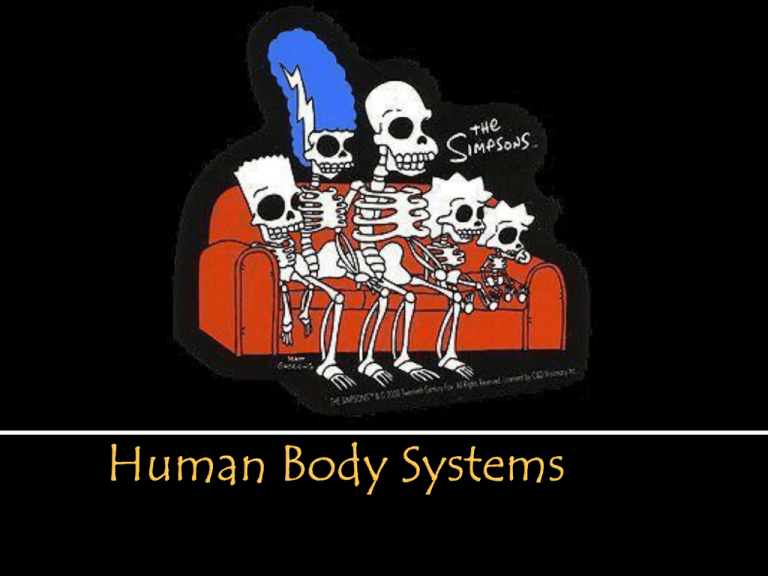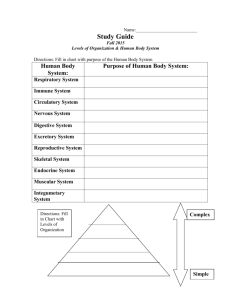Human Body Systems
advertisement

Every cell in the human body is both an _________________ and in ______________________ of a larger community – the entire organism. How does the body get the cells to work together? Every cell in the human body is both an Independent unit and in Interdependent part of a larger community – the entire organism. How does the body get the cells to work together? The levels of organization in a multicellular organism include (from smallest to largest) _____, _________, ___________, and ______________ , which work together to perform the functions of the body. The levels of organization in a multicellular organism include (from smallest to largest) cells, _________, ___________, and ______________ , which work together to perform the functions of the body. The levels of organization in a multicellular organism include (from smallest to largest) cells, tissues, ___________, and ______________ , which work together to perform the functions of the body. The levels of organization in a multicellular organism include (from smallest to largest) cells, tissues, organs, and ______________ , which work together to perform the functions of the body. The levels of organization in a multicellular organism include (from smallest to largest) cells, tissues, organs, and organ system, which work together to perform the functions of the body. Cells – A cell is the ____________________________ Specialized cells are uniquely suited to perform a particular function. Cells – A cell is the basic unit of structure and function in living organisms Specialized cells are uniquely suited to perform a particular function. ______________________ – A group of cells that perform a single function is called a tissue. There are 4 basic types of tissue: 1.____________________ – glands and tissues that cover interior and exterior body surfaces (ex: skin) 2.____________________ – provides support for the body and connects its parts (ex: bone, cartilage) 3.____________________ – transmits nerve impulses (ex: nerve cells, brain cells) 4.____________________ – enables the body to move (ex: heart, bicep) Tissue– A group of cells that perform a single function is called a tissue. There are 4 basic types of tissue: 1.____________________ – glands and tissues that cover interior and exterior body surfaces (ex: skin) 2.____________________ – provides support for the body and connects its parts (ex: bone, cartilage) 3.____________________ – transmits nerve impulses (ex: nerve cells, brain cells) 4.____________________ – enables the body to move (ex: heart, bicep) Tissue– A group of cells that perform a single function is called a tissue. There are 4 basic types of tissue: 1.Epithelial tissue – glands and tissues that cover interior and exterior body surfaces (ex: skin) 2.____________________ – provides support for the body and connects its parts (ex: bone, cartilage) 3.____________________ – transmits nerve impulses (ex: nerve cells, brain cells) 4.____________________ – enables the body to move (ex: heart, bicep) Tissue– A group of cells that perform a single function is called a tissue. There are 4 basic types of tissue: 1.Epithelial tissue – glands and tissues that cover interior and exterior body surfaces (ex: skin) 2.Connective tissue– provides support for the body and connects its parts (ex: bone, cartilage) 3.____________________ – transmits nerve impulses (ex: nerve cells, brain cells) 4.____________________ – enables the body to move (ex: heart, bicep) Tissue– A group of cells that perform a single function is called a tissue. There are 4 basic types of tissue: 1.Epithelial tissue – glands and tissues that cover interior and exterior body surfaces (ex: skin) 2.Connective tissue– provides support for the body and connects its parts (ex: bone, cartilage) 3. Nervous tissue – transmits nerve impulses (ex: nerve cells, brain cells) 4.____________________ – enables the body to move (ex: heart, bicep) Tissue– A group of cells that perform a single function is called a tissue. There are 4 basic types of tissue: 1.Epithelial tissue – glands and tissues that cover interior and exterior body surfaces (ex: skin) 2.Connective tissue– provides support for the body and connects its parts (ex: bone, cartilage) 3. Nervous tissue – transmits nerve impulses (ex: nerve cells, brain cells) 4.Muscular tissue – enables the body to move (ex: heart, bicep) organs – A group of different types of tissues that work together to perform a single function is called an organ. _______________________ – An organ system is a group of organs that perform closely related functions. organs – A group of different types of tissues that work together to perform a single function is called an organ. Organ system– An organ system is a group of organs that perform closely related functions. Cells Tissues Organs Organ System Organism The eleven organ systems of the human body work together to maintai homeostasis in the body as a whole. Homeostasis is the ability to keep an internal balance despite changes in external conditions. Examples: •When your body temperature gets too high, you sweat. •When your body temperature gets too low, you shiver. •When your diaphragm (your breathing muscle) gets irritated, you hiccup. The_hypothalmus is the area of the brain that controls homeostasis. In order to maintain homeostasis, your body relies on a feed back system_. Negative Feedback – The body produces a response that is the opposite of the stimulus. This keeps the body in balance. Ex – cold temperatures produce a shivering effect to keep warm Positive Feed back – the body overproduces a response to a stimulus in order to prevent shock or damage. Ex – The body produces an unusual amount of adrenaline when scared in order to enhance “fight or flight” mode The 4 ways we will study body systems is to categorize them into the following functions: 1. Regulation: Excretory & Nervous Systems 2. Nutrient absorption: Respiration, digestion and circulatory systems 3. Defense: Immune, Integumentary, Lymphatic, Skeletal, & Muscular systems 4. Reproduction: Reproductive & Endocrine systems Muscular System Provides movement Skeletal System Supports the body and protects organs Circulatory System Transports nutrients and gases Nervous System Transmits messages through the body Lymphatic (Immune) System Protects the body against infection Respiratory System Facilitates gas exchange with the environment Endocrine System Produces hormones and is responsible for growth and development Thyroid gland Digestive System Breaks down food into chemical energy that the body can use Excretory System Removes toxins from the body Reproductive System Produces offspring Integumentary system Skin – protects the body Write this on your notes. There is no picture







